Will Spilled Liquid Calcium Chloride Go Away?
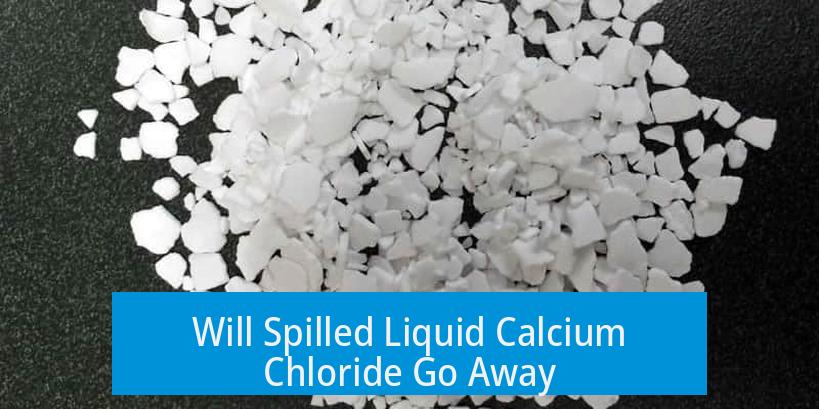
Spilled liquid calcium chloride will mostly go away through thorough and repeated washing with plain water; however, its hygroscopic nature causes persistent dampness that may remain for a long time, potentially leading to damage on surfaces like wood, metal, or porous materials. This article details the behavior of calcium chloride spills, effective cleaning methods, common issues, and the challenges associated with complete removal.
Understanding Calcium Chloride and Its Spill Characteristics

Minor Corrosiveness and High Solubility
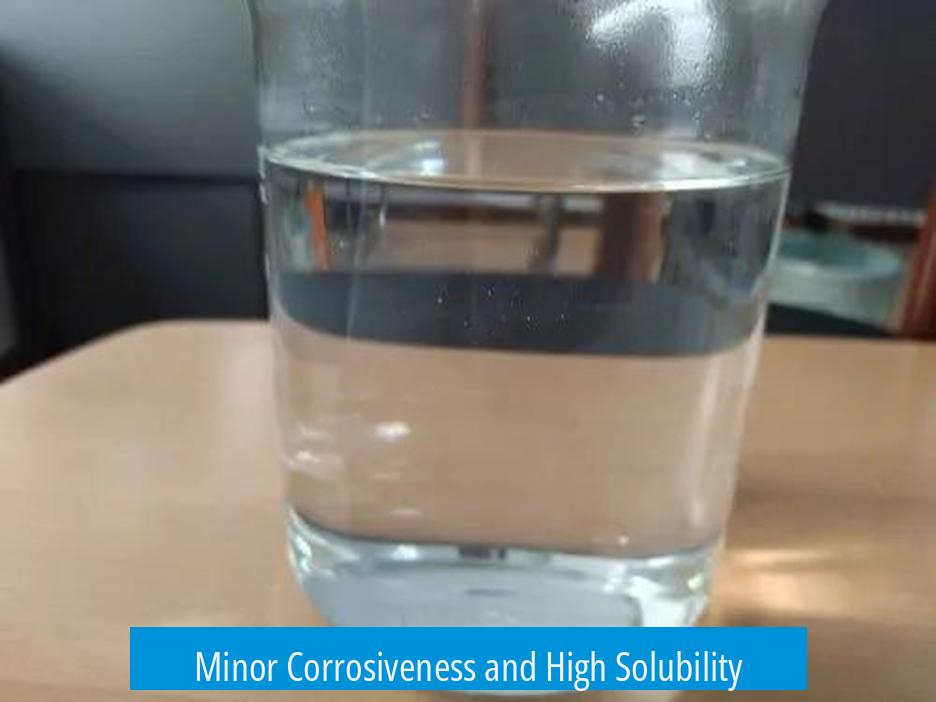
Calcium chloride is a salt widely used for de-icing, dust control, and moisture absorption. It is not notably corrosive except toward certain metals. Its water solubility is very high, meaning spills readily dissolve in water, making physical removal feasible.
Unlike some chemicals, calcium chloride does not pose a risk to fabrics or plastics by corrosion. This property simplifies cleanup on these surfaces.
Hygroscopicity and Moisture Attraction
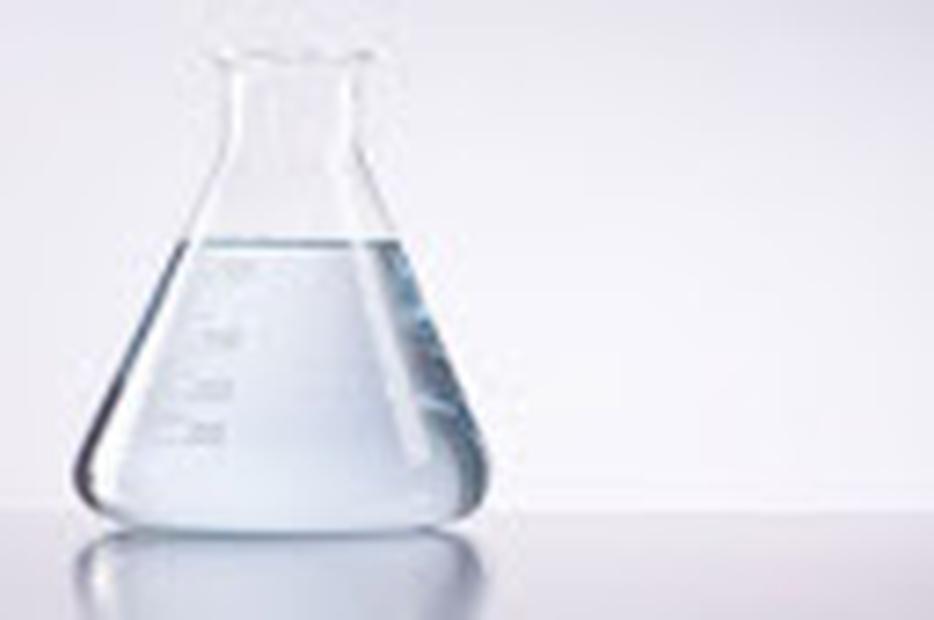
One key property influencing spill cleanup is calcium chloride’s hygroscopic nature. It absorbs moisture from the air continuously. This trait means even after wiping or vacuuming, the spill may remain damp by pulling in ambient moisture.
Because it never truly dries out, spilled calcium chloride can maintain a persistent wet spot on floors, vehicle trunks, or other surfaces, sometimes lasting for years. Such constant dampness can cause secondary issues.
Effective Cleanup Methods for Calcium Chloride Spills
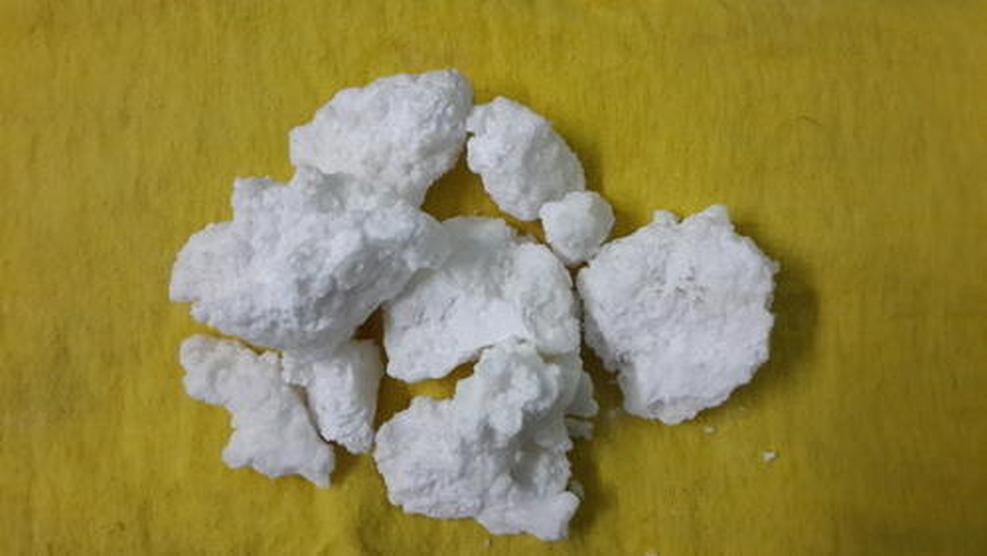
Repeated Water Washing
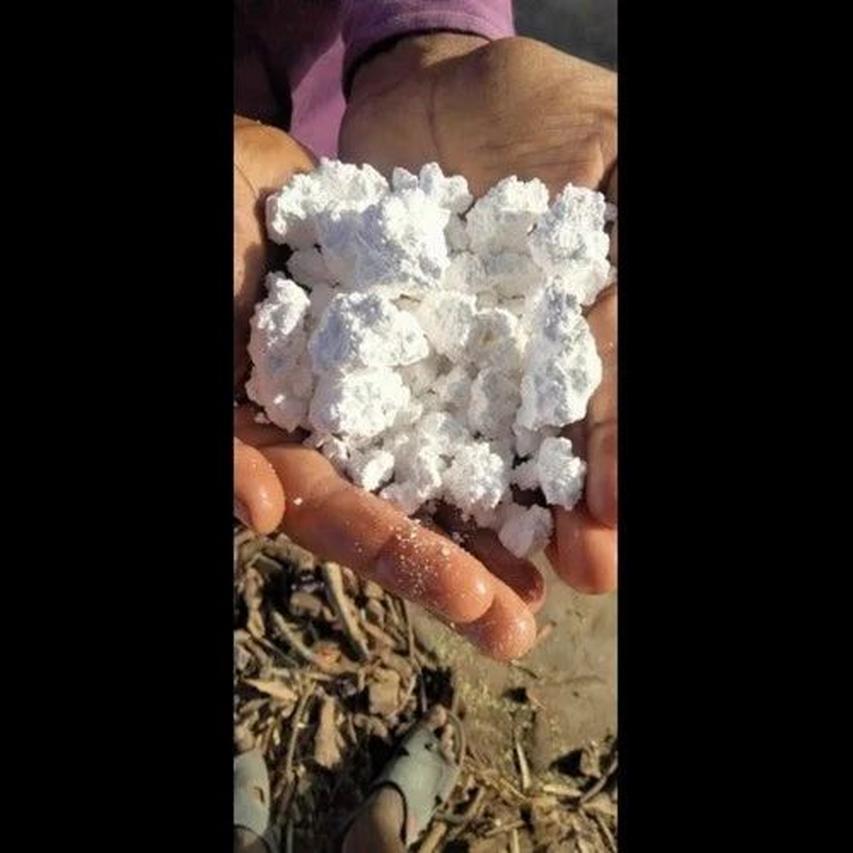
- Use plenty of plain water to flush the spill multiple times.
- Water dilution reduces salt concentration and washes away calcium chloride residues.
- Repeated rinsing is crucial due to the salt’s hygroscopic property.
- Avoid using minimal water amounts that only partially dissolve the salt.
Thorough water washing effectively reduces calcium chloride concentration, eliminating much of the residue. Users report success simply by soaking and rinsing the affected area multiple times.
Avoid Soap or Detergents During Cleanup
Cleaning attempts with soaps or detergents are generally not recommended. Plain water alone is preferred because:
- Detergents might leave residues that interact unpredictably with calcium chloride.
- They do not help dissolve the salt better than water.
- Simpler cleaning avoids introducing unnecessary chemicals.
Special Considerations for Laundry
If calcium chloride contacts textiles such as cotton:
- Rinse immediately with cold water before laundering.
- Prompt washing reduces the chance of salt embedding deeply in fibers.
- Cold water prevents setting residues or damaging fabric.
Challenges and Persistent Problems After Spills
Constant Dampness and Rust Formation
The salt’s ability to absorb moisture can cause long-term wet spots. For example, people have reported moisture zones on garage floors persisting years after a spill.
More severe problems occur with metals and wood:
- Calcium chloride solution accelerates rust on metals.
- It damages and weakens wood over time.
- Repeated water flushing is necessary to remove residue and reduce these effects.
Even after extensive cleaning, the environment may remain slightly damp, promoting corrosion or structural damage.
No Known Chemical Neutralizer
Attempts to chemically neutralize spilled calcium chloride have been largely unsuccessful. Ideal neutralization would involve:
- A harmless chemical that converts calcium chloride into a stable, non-hygroscopic compound.
- No surface damage or adverse reactions.
Currently, no such chemical is known for practical use. Suggestions like baking soda followed by vinegar cleaning have been considered but lack proven effectiveness.
Misidentifying Residues
Calcium chloride does not produce oily residues. If an oily or greasy spot appears after a spill, it likely stems from a different source. This distinction helps guide cleaning efforts effectively, using detergents or degreasers when appropriate.
Effects on Items and Materials
Impact on Porous Materials Like Books
Liquid calcium chloride spilled on books or paper causes irreversible damage. Salt deposits absorb moisture, deform pages, and weaken paper fibers. There is no safe method to restore soaked books completely.
Damage to Wood and Metal
Strong calcium chloride solutions harm wood by bringing excess moisture and salt, leading to warping and decay.
Metals are at risk of accelerated rust, especially in confined, damp spaces like vehicle trunks, compounding maintenance challenges.
Addressing Health and Surface Concerns
Surface Residues and Irritation
Some users report persistent irritation such as throat dryness following exposure to calcium chloride spills in confined areas. This is due to the salt’s hygroscopic nature drawing moisture from mucous membranes.
Cleaning does not always remove this effect entirely if residual salt remains. Proper ventilation and thorough washing help mitigate discomfort.
Summary of Key Points
- Calcium chloride spills are water-soluble and best removed by repeated flushing with plain water.
- Do not use soap or detergents during cleanup; water alone suffices.
- Its hygroscopic property causes persistent dampness that can attract moisture indefinitely.
- Long-lasting damp spots can damage wood and metal via corrosion and decay.
- No practical chemical neutralizer exists to eliminate calcium chloride without damaging surfaces.
- Spills on porous materials like books often cause permanent damage.
- Oily residues are not caused by calcium chloride; separate cleaning strategies matter.
- Repeated water washing and ventilation help minimize health effects and residue build-up.
Will Spilled Liquid Calcium Chloride Go Away?
Yes, spilled liquid calcium chloride can go away with repeated washing using just water, but it doesn’t magically disappear overnight and can cause lingering problems due to its moisture-attracting nature. So, if you had an unfortunate spill, don’t despair—you have a remedy. But, be prepared for a bit of a cleanup adventure.
Let’s dive into the nitty-gritty of this cleanup, what calcium chloride really does to your stuff, and why sometimes the spot seems to stick around forever.
The Nature of Calcium Chloride Spill
First, calcium chloride isn’t the villain you might think. It doesn’t corrode fabrics or plastics, but it does play rough with metals and wood. Why? Because it’s highly water-soluble, which means it loves to dissolve in water and is usually easy to wash away—if you know how to handle it.
This means if you spill it on your jacket or a plastic bin, it won’t eat through the fabric or material. But a neat trick you’ll want to remember: it’s best not to reach for soaps or detergents to clean it.
How to Get Rid of It: Water, Water, and More Water
Here’s a pro tip—skip the soap. The best way to clean spilled calcium chloride is with repeated rinses of plain water. Just pour lots of water over the spill several times. That’s your best bet to flush it all away.
If it gets on something washable like cotton fabric, rinse with cold water immediately before tossing it in the laundry. Hot water or detergents can sometimes make things worse by interacting with it or spreading it.
If your spill is on a hard surface like a garage floor or wood, keep rinsing. Be patient. Calcium chloride holds onto moisture because it’s hygroscopic—it sucks water from the air and won’t dry easily. This means after cleaning, the area might stay damp for a while longer, potentially causing rust or damage to wood or metal surfaces.
The Sticky Situation: Why Calcium Chloride Spots Seem to Stay Forever
Have you noticed a constant wet spot where you spilled it? You’re not alone. There are reports of wet patches lingering for years, thanks to calcium chloride’s habit of grabbing moisture right from the air. It creates an endlessly damp environment that won’t dry out.
This moisture attraction can cause ongoing problems like rust on nearby metal or damage to wood. Even after using a wet vacuum or wiping it several times, the dampness might just refuse to vanish.
Contrary to some myths, calcium chloride does not leave oily spots. If you see anything oily, it’s a different issue. For those, try a mild soap or detergent cleanup.
Can You Use Something Other Than Water to Neutralize It?
Many have hunted for a miracle chemical to zap calcium chloride into oblivion. Unfortunately, there’s no well-known chemical that reacts safely with calcium chloride to neutralize it without risking surface damage.
Some consider baking soda or vinegar. While these household items are tempting, their effectiveness for calcium chloride cleanup is uncertain and might harm surfaces. So, stick with water and patience.
The Problem with Porous and Sensitive Things—Say, Your Books
If you accidentally splash calcium chloride on books or paper, brace yourself. The spill might irreversibly damage them. The moisture attraction can cause pages to warp, stick, or mold, and sadly, there’s no quick fix once damage sets in.
Wood and metal face similar risks. The calcium chloride solution can weaken and corrode these vulnerable materials, so cleaning quickly and thoroughly is crucial.
Health Effects to Consider
A spilled calcium chloride solution from a small dehumidifier once left someone with a persistent dry throat and irritation after the spill. The residue—though not oily—remained hard to remove and caused discomfort. So, beyond cleaning up your floors and walls, watch out for any breathing or skin irritation symptoms.
Summary: What To Do When Liquid Calcium Chloride Spills
- Use plenty of water alone, no soaps or detergents, and rinse the affected area multiple times.
- Be ready for lingering dampness due to its hygroscopic properties.
- Avoid letting it sit on metals, wood, or porous items to prevent damage.
- Oily stains are not calcium chloride; clean those with soap separately.
- No reliable chemical neutralizers exist, so patience and water are your best friends.
- If it spills on clothes, rinse with cold water before washing.
- Watch out for irritation—ensure proper ventilation and clean up thoroughly.
So, what will you do the next time calcium chloride makes a surprise appearance on your floor? Do you have an elderly mop and a watering can ready? It pays off!
Even though it’s not the easiest to banish entirely, calcium chloride spills do go away with the right care and patience. Don’t rush it. Keep flushing, keep drying, and keep your eye on those damp spots like a hawk.
And maybe—just maybe—store that bag far from your bookshelves, floors, and your lucky metal wrench.
Will spilled liquid calcium chloride completely disappear over time?
No, it won’t just disappear. Calcium chloride attracts moisture from the air, so it can keep surfaces damp for a long time. Repeated water washing is needed to remove it fully.
Can I use soap or detergent to clean up a calcium chloride spill?
It’s best not to use soap or detergent. Just rinse the area with plenty of water multiple times to dissolve and wash away the calcium chloride.
Why does the area stay wet even after cleaning a calcium chloride spill?
Because calcium chloride is hygroscopic, it keeps pulling moisture from the air. This makes the spot stay damp and can lead to rust or damage on metals and wood.
Is there a chemical that can neutralize spilled calcium chloride safely?
No known safe chemical reaction neutralizes calcium chloride on surfaces without risk. Attempts with baking soda or vinegar have not proven reliable.
Can calcium chloride spill damage items like books or wood?
Yes, spills on porous materials like books can cause permanent damage. It can also harm wood and metal due to its moisture-attracting nature.
Why might there be an oily residue after a calcium chloride spill?
Calcium chloride itself does not create oily residues. If you see oil spots, it is likely from another source and should be cleaned with soap or detergent.


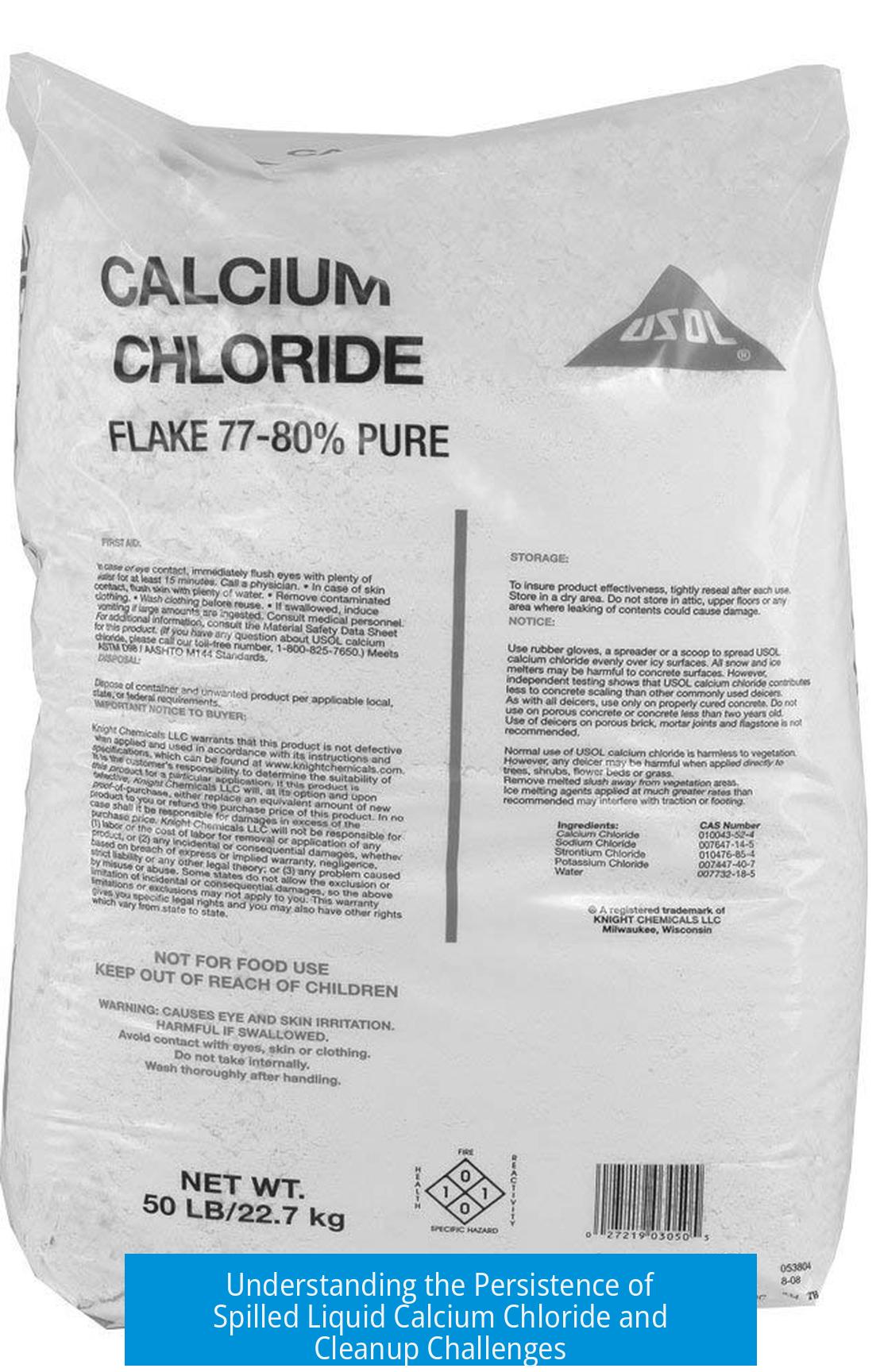

Leave a Comment